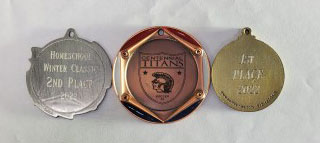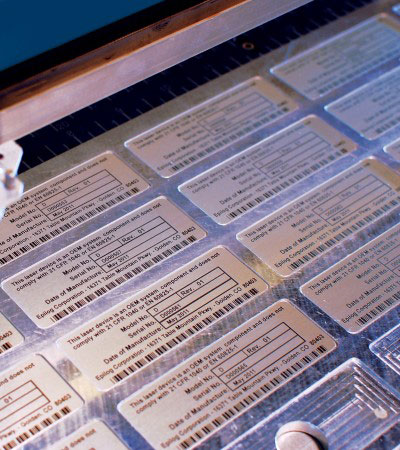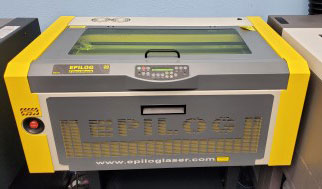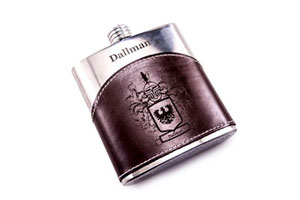True, fiber lasers aren’t exactly new. After all, they’ve been used for decades in industrial applications. But fiber lasers have recently gained ground in the personalization industry, with smaller shops even reaping benefits from investing in such equipment. That’s in part because fiber lasers offer more versatility with metal applications than CO2 lasers and are faster and easier to use than mechanical engravers. The global fiber laser marking machine market is projected to have a 10.9% compound annual growth rate from 2017 to 2024, according to research that Research Nester compiled and released last year.
The Fiber Laser Buzz
While cost remains a major concern, small and medium-sized retailers can reap plenty of benefits.
By Kate Rockwood
(Originally published in the March/April 2022 issue of Insights.)
True, fiber lasers aren’t exactly new. After all, they’ve been used for decades in industrial applications. But fiber lasers have recently gained ground in the personalization industry, with smaller shops even reaping benefits from investing in such equipment. That’s in part because fiber lasers offer more versatility with metal applications than CO2 lasers and are faster and easier to use than mechanical engravers. The global fiber laser marking machine market is projected to have a 10.9% compound annual growth rate from 2017 to 2024, according to research that Research Nester compiled and released last year.
The industry standard for some time now, CO2 lasers are named for their main component —
a gas-filled tube. Electricity is pushed through the tube with mirrors positioned to direct the laser beam, vaporizing the material to engrave it. While they work beautifully on a wide range of substrates from acrylic to glass, leather to wood, there are a handful of materials they don’t work on—most notably bare metals (unless you apply a chemical marking agent).
That’s where fiber lasers come in handy. Fiber lasers—named for their fiber-optic element—are characterized as having a much higher density of power at the laser’s focal point than CO2 lasers. The smaller beam size and, therefore, higher energy density, allow for a finer, faster cut and more variety in the style of the engraving than their CO2 counterparts. And for metals, better absorption and lack of reflection during the process are major benefits.
If your customers want personalization on steel, then you need a fiber laser, says Jeff Karnuth, owner of aai Trophies and Awards in Plano, Texas. “You couldn’t do stainless steel in most of the normal shops in the country,” he says. “You’ll need a special diamond tip to go into the steel, and depending on the application, you’d have to fill that in with color. You couldn’t even use a diamond tip on stainless steel or metal because you’d have nothing to see.”
Some of the many applications for fiber lasers include marking industrial and automotive parts and tools, medical and dental implements, large metal signs, metal drinkware (like the popular Yeti insulated cups and water bottles), eating utensils, awards, medals, jewelry, guns, lighters
and watches.
Fiber lasers are a big investment, though. Until recently, the assumption has often been that only larger shops have the luxury to buy one. But many smaller shops are finding that not only can a fiber laser be an extremely useful piece of equipment, it can also open up new areas of business, bringing in extra revenue that can ultimately pay for a fiber laser’s cost.
“The really nice thing about a fiber laser is that it can mark literally any type of metal,” says Ryan Huddleston, founder of Enduramark in Austin, Texas. “It’s a permanent mark. You don’t have to worry about it ever fading or being removed because it’s actually marking into the metal. A marking chemical can be removed by something like sandpaper or sandblasting, and not every metal will work with it.”
So, is a fiber laser right for your business? Here’s what you need to know before diving into that capital investment.
Marked for Success
When comparing fiber lasers and CO2 lasers, the main consideration is whether you have business that requires marking noncoated metals. If the answer is yes, then it might be time to invest in fiber. (See “The Fiber Laser Advantage” sidebar for a quick overview of the benefits.)

aai Trophies' selection of fiber-laser engraved medals
The Edge Over Engravers
But what about traditional engravers? Fiber lasers only mark metals and can’t engrave like mechanical, or rotary, engravers. But they can reproduce the look of engraving and are faster and more user-friendly.
“Fiber lasers are a great substitution for mechanical engraving systems,” says Mark Case, president of The Finer Line, Inc., Itasca, Illinois. “Although they can’t completely replace a traditional engraving system, they can outperform them in speed, detail and ease of use.”
Case’s shop has three mechanical engraving systems that mostly sit idle while his four fiber lasers do the bulk of the work. And they do it a lot faster, to boot. “Depending on the laser, you can engrave something in eight to 15 seconds versus one to three minutes on a traditional engraving machine,” Case says, adding that fiber lasers make fixturing and clamping products “a breeze.”
Imagine you had to mark the back of 100 award medals, Karnuth says. Using a rotary engraver with a diamond tip, you’d have to change them out each time, which costs labor and money. With a fiber laser, you can do them in batches of 20 to 50, and do the job 10 times faster, he says.
Charlie Drago of Monarch Trophy Studio in San Antonio agrees: “A very large part of our business is schools, and we’re always engraving little school medals. With fibers you can load a whole bed of metals and walk away.”

Laser marking metal asset tags with a fiber laser, from Epilog Laser
The Edge OverCO2 Lasers
Compared to their CO2 counterparts, fiber lasers last longer and are easier to maintain. While a CO2 laser can run about 3,000 to 5,000 hours before the tube needs to be replaced or recharged, the lifespan of a fiber laser is around 100,000 hours, according to Huddleston. “I’m looking at replacing the CO2 every three to five years,” he says. “I’ll probably never have to replace the fiber laser.”
Still, Karnuth advises keeping fiber laser machines clean, staying up to date on routine maintenance and getting rubber belts and other pieces replaced when they show wear. Better yet, learn to replace the parts yourself. As he puts it, “If the machine ain’t running, you ain’t making money.”

An Epilog laser
Fiber Laser Drawbacks
The fiber laser disadvantage boils down to the learning curve, cost and substrate limitations.
One of the things that gives fiber an edge over CO2 lasers also works against it: more settings. “In general, if you’re engraving with CO2, you set three things: power, speed and resolution,” Huddleston explains. “When talking about a fiber laser, it gets more complicated because you have power, speed, frequency, resolution and focus. You can change the way your marking looks based on the focus.” As a result, the learning curve for fiber lasers is steeper. That said, it’s a lot easier to learn to use a fiber laser than it is to learn a diamond drag.
But the biggest barrier holding many businesses back from buying a fiber laser is the cost, which is typically higher than comparable CO2 lasers. And, simply put, not everyone needs what a fiber laser offers. The versatility of CO2 lasers might suffice for your business requirements. CO2 lasers might not be as versatile with all metals, but they allow you to work with all substrates, including glass.
“If you operate more on the industrial side, a fiber laser will work really well for you,” Huddleston says. “If you’re a promo shop, a fiber laser might not make as much sense. If you do very little metal marking, then it doesn’t make any sense to have a fiber laser.”
“Some of the shops in small towns aren’t going to have the need for a fiber mark,” Karnuth says. “If you’re anywhere near any sort of metropolitan area, even the suburbs, I can’t see not having one.”
Maximizing ROI
As with any capital investment, you’ll want to think about how to maximize your return on investment, including planning to minimize your interest rate, maximize sales and increase productivity.
If you decide to invest in a new fiber laser, first consider how long it will take to make back the money you spent. Case says that depending on your volume and the fiber you buy, you can expect to get a return on your investment in one to three years. “Like any investment, if you can’t see making your money back in at least four years, don’t do it,” he cautions.
If you decide to pull the trigger, don’t just sit around and wait for money to roll in. There are smart steps you can take to lessen the financial burden from the outset and ensure that you bring in new business to make up the cost.
“When I buy my equipment, I pay for it in cash. I start saving ahead of time,” says Karnuth. In general, retailers should shop around to secure the best financing deal possible, whether that be from a bank or an industry-specific lender.

A multi-material flask of wood and leather engraved with a dual-source Epilog Laser system.
Once you’ve made the purchase, it’s all about marketing. As much as possible, expand your outreach and sell your new capabilities to current and prospective clients. “I made up a flyer strictly for the fiber mark and sent them to construction companies and machine shops that deal with metal and manufacturing—places that need IDs on their metal—to let people know that we could do it,” Karnuth says.
Effective marketing post-purchase also means actively widening your customer base, from welders and metalsmiths to jewelers and artisans. “The people I know who’ve been successful with their fiber lasers have gone out and found those customers,” Huddleston says. “One guy reached out to an artist who made sculptures out of metal. He would put the artist’s signature on them.”
If the market doesn’t present itself, make a new one, says Drago. “We engrave lots of tools and pieces of cars because we’ve created a market where people know we have these lasers,” he says.
When you bring customers in, don’t undersell your business either. “Charge a premium for products you run on the fiber laser,” Case says. “Just because it’s easier to produce something on a fiber doesn’t mean you charge less. You made the investment, and you need to get a return on it. Remember, time is money. Even though you might be able to do many of the things a fiber can do with traditional engraving, you can’t do them as quickly.”
Case adds that retailers should put the time saved from these lasers to good use: “Think about all the time this type of machine will free up for your staff to do something else—another job, marketing, cleaning, maintenance. The list goes on and on.”
While a fiber laser might not be necessary for every shop, owners who have taken the plunge are glad they did—and encourage others to jump into the fiber pool, too.
“I think when we first saw them, they were the machines of the future,” Drago says. “If you want your business to survive, you have to stay up on the latest technology.”
The Fiber Laser Advantage
What fiber lasers offer:
- Marking instead of engraving, providing more versatility.
- More opportunities for metal marking: industrial marking, promotional products and large-volume jobs. Fiber lasers can mark literally any type of metal.
- Photo reproductions.
- Unlimited fonts.
- Three different looks: hard etch, polish and anneal marking.
- Less training than diamond cutters, with easier-to-run software.
- Faster speeds than engravers.
- Easier fixturing and clamping.
- Avoiding the use of chemical agents, like with CO2 lasers, which eliminates fading and the cost of chemical agents.
- A longer lifespan and less maintenance. Replacing parts is faster because they’re manufactured in the U.S.
Wondering if a fiber laser is right for your shop?
Head to our Member2Member Forum at bit.ly/apaforum to talk with others who have taken the plunge.